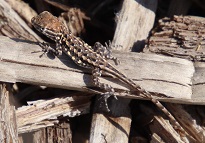Common Side-Blotched Lizard (Uta stansburiana)
Description: The common side-blotched lizard is a species of small iguanid lizard. Males can grow up to 2.4 inches from snout to vent, while females are typically a little smaller. The degree of pigmentation varies with sex and population. Some males can have blue flecks spread over their backs and tails, and their sides may be yellow or orange, while others may be unpatterned. Females may have stripes along their backs/sides, or again may be relatively drab. Both sexes have a prominent blotch on their sides, just behind their front limbs. Coloration is especially important in common side-blotched lizards, as it is closely related to the mating behavior of both males and females. The different throat morphologies that the side-blotched lizard adopts also affects their sprinting speed. Across all three morphs, sprinting speed is positively correlated with blue hue, the brightness of the yellow throat, and the level of saturation of the orange throats. While aspects of throat coloration are positively related to sprinting speed and mass of the lizard, they do not affect the lizard’s snout-vent and hind limb length.
Habitat: Habitats include a wide variety of arid and semiarid situations with scattered bushes and/or scrubby trees; soil may be sandy, gravelly, or rocky; the species is often found in sandy washes with scattered rocks and bushes. Eggs are buried in sandy soil.
Range: The geographic range extends from central and northeastern California, central and eastern Oregon, central Washington, southwestern Idaho, Utah, and western Colorado southward to the tip of Baja California, northern Sinaloa, and northern Zacatecas, Mexico, including many islands along the Pacific coast of Baja California and in the Gulf of California. Elevational range extends from below sea level in desert sinks to about 9,000 feet.
Diet: Side-blotched lizards display feeding behavior which can be influenced by sex or season. In a study conducted by Best et al.., these lizards were found to consume diets largely based upon arthropod populations within the area, within a given season. These populations vary by year, and different arthropod populations will fluctuate seasonally. The study showed a correlation between sex and diet, giving way to a number of theories that speculate why gender has an effect on feeding behavior and diet. One mechanism proposes the behavior differences depend on gender, such as guarding territories and attracting mates, are responsible for, or a contributing factor in, feeding behavior. Alternatively, the sexual difference in feeding behavior could also act in favor of reducing intraspecific competition for resources, with individuals eating prey appropriate for their respective size (ex. small females consuming smaller prey).
Reproduction: In most of the range, courtship and mating occur in spring as lizards emerge from hibernation. Reproductive females produce 1-3 clutches of 1-5 eggs in the northern part of the range, 2-7 clutches of 1-8 eggs in the south. Egg laying begins as early as March in the south, by mid-April in Colorado, and extends through July or August in many areas. Females bury eggs in sandy soil. Eggs hatch in late July and August in Colorado, as early as late June in Texas, Nevada, and Idaho. Individuals become sexually mature in 1-2 years.
Status: Listed as Least Concern in view of the large and stable extent of occurrence, area of occupancy, number of subpopulations, and population size. No major threats are known.
This article uses material from the Wikipedia article "Common Side-Blotched Lizard", which is released under the Creative Commons Attribution-Share-Alike License 3.0. Content may have been omitted from the original, but no content has been changed or extended.
|








